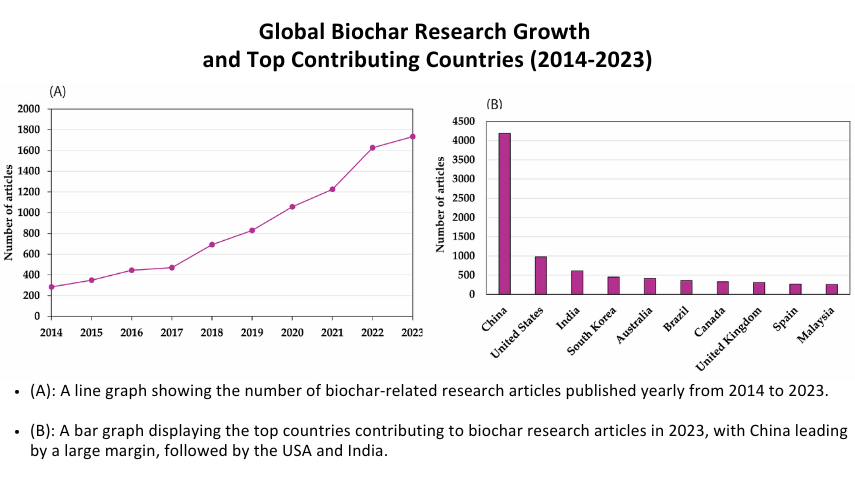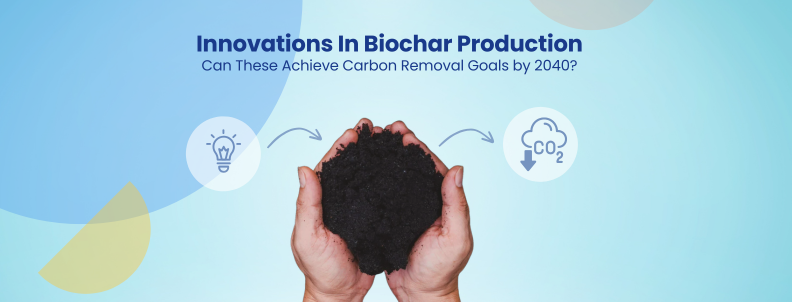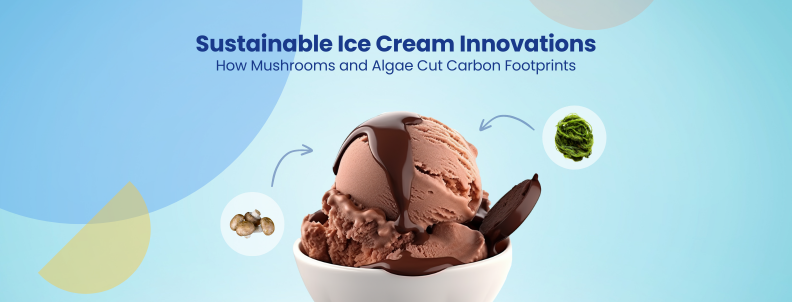In 2023, biochar carbon removal represented over 90% of delivered carbon credit.
At an average cost of $176 per tonne, it is the most cost-effective offsetting technique compared to nature-based solutions, which average $27 per tonne. This affordability has significantly attracted buyers and made biochar a dominant player in carbon offset marketplaces.
The biochar industry is growing fast, producing over 350,000 metric tonnes annually and aiming to remove a gigaton of carbon by 2040. Innovators worldwide are researching ways to enhance the qualities of biochar for carbon removal. Multiple techniques of biochar production, such as hydrothermal carbonization, gasification, microwave-assisted pyrolysis, and flash carbonization, are being researched.
China is leading this research, followed by the USA and India.

However, the industry is not without its challenges.
Key Challenges in Biochar Production
- Inconsistent Composition: Biochar quality depends on feedstock type and pyrolysis conditions. Low-quality biochar significantly hinders its effectiveness in carbon capture.
- Feedstock Availability: Large-scale production requires a consistent and sustainable biomass supply, such as agricultural or forestry residues. Securing sufficient quantities of feedstock is difficult, especially when competing with other industries for the same resources.
- Production Costs: The pyrolysis process to create biochar is energy-intensive and expensive. As the industry scales, the costs associated with building and maintaining production facilities can become restrictive.
- Logistical Challenges: Biochar is lightweight but bulky, which makes transportation inefficient and costly. 50% of the cost of biochar is just logistics. Transporting large volumes of biochar over long distances can negate its environmental benefits due to the associated carbon emissions from transportation.
While these challenges have posed significant hurdles for the biochar industry, innovations in production techniques worldwide offer transformative solutions. This article delves into some of those breakthroughs.
Emerging Innovations in Biochar Production Methods
Applied Carbon’s Innovative Reactor Design: Using Catalysts to Enhance Biochar Yield
Applied Carbon (previously Climate Robotics) is reshaping biochar production with a novel reactor design that uses catalysts to boost biomass conversion. Catalysts like phosphoric acid, iron, rare earth metals, and pyrolysis-recovered ash are infused into biomass before thermal conversion.
This approach directs how the material breaks down to increase yield and fine-tune biochar properties for specific applications. The catalyst-assisted technique ensures that every batch of biochar is tailored to maximize benefits like soil enrichment and effective carbon capture. The cutting-edge technology marks a significant leap forward in sustainable innovation that aligns with environmental goals and industry needs.
Applied Carbon’s Biochar Robot: Turning Crop Waste into Biochar On-site
Applied Carbon’s innovative solution revolutionizes biochar production by bringing the process directly to the farm.
The tractor-pulled machine processes crop waste into biochar and syngas through high-temperature pyrolysis. Biochar is immediately spread onto the soil, while syngas powers the system, making it self-sufficient. Biochar boosts soil health, enhances crop yields, and provides long-term carbon removal and storage.
Founders Jason Aramburu and Morgan Williams aim to solve logistical challenges with this invention. Traditional biochar production involves transporting plant waste to facilities and then returning the biochar to farms. This process was costly and energy-intensive, often negating the carbon benefits. Applied Carbon’s unique solution reduces biochar’s per-ton cost by eliminating the need for costly transport, transforming sustainable agriculture.

The innovative technology earned the prestigious $500,000 Wilkes Climate Launch Prize.
Applied Carbon has attracted support from several high-profile investors, including TO VC, Microsoft Climate Innovation Fund, Congruent Ventures, and the Grantham Foundation. It has secured $21.5 million in Series A funding. This underscores industry confidence in its potential to transform sustainable agriculture and carbon removal efforts. Applied Carbon aims to scale production and bring its mobile biochar units to farms across the U.S., positioning its technology as a key player in the fight against climate change.
High Plains Biochar LLC’s Energy-Efficient Solutions
US-based High Plains Biochar LLC is at the forefront of biochar carbon removal. The company’s flagship product, the RocketChar 301, is an energy-efficient biochar furnace utilizing rocket stove technology.
This furnace processes various biomass materials, including wood chips and agricultural residues, without the need for external fuels like propane or natural gas. It operates on minimal electricity, making it a sustainable option for biochar production.
In 2024, Canadian agricultural cleantech company HEMPALTA purchased two advanced biochar units from High Plains Biochar LLC, underscoring the company’s promising solution.
High Plains Biochar LLC has also developed a continuous pyrolysis system that produces biochar using a self-sustaining reactor design. The specialized reactor includes two combustion chambers linked by a vertical riser, eliminating the need for external blowers. Additionally, gases and oils released during the process flow into the combustion chambers, where they’re burned to create heat. This approach enhances energy efficiency and reduces external energy requirements.
Salt-Assisted Pyrolysis for Enhanced CO₂ Capture: Chinese Universities’ Breakthrough in Bamboo Biochar
Researchers from Jiangsu University, Anhui Agricultural University, and Ningbo University of Technology in China have developed salt-assisted pyrolysis to enhance biochar’s ability to capture CO₂. The study used bamboo as a feedstock due to its environmental friendliness, low cost, and renewability. Bamboo biochar (MBCx) was prepared by heating bamboo powders in a mixture of eutectic salts (Li₂CO₃ + K₂CO₃) at temperatures between 500°C and 600°C in the presence of air. Results showed that MBCx had superior properties to conventional bamboo biochars prepared in a nitrogen atmosphere without salt. The process boosted oxygen content and created more carbon defects, which enhanced the biochars’ ability to capture CO₂. This breakthrough addressed two critical challenges of the industry: finding a sustainable, affordable feedstock and enhancing biochar’s effectiveness in carbon capture.
Two-Stage Torrefaction Technology For Efficient Production: Moscow Power Engineering Institute
Moscow Power Engineering Institute’s two-stage torrefaction technology is set to redefine biochar production with a highly efficient, streamlined process. This innovation optimizes biochar output using a specialized hearth-type reactor. The reactor dries and torrefies biomass on upper trays and incorporates an intelligent cooling phase on lower trays. Here, cooling water vaporizes upon contact with the torrefied biomass, eliminating the need for extra steps like biomass separation and drying—saving both time and resources.

One of the key advantages lies in its environmental and operational efficiencies. By consuming only 0.3 liters of water per kilogram of biomass, this technology drastically reduces water use compared to traditional methods. Moreover, the potential to recycle water-rich byproducts highlights its environmentally responsible design.
Performance tests on sunflower husks reveal another strategic benefit: a significant reduction of alkali metal chlorides and sulfur compounds in the biochar ash. This reduction is crucial as it mitigates the risk of corrosion in boilers where ash buildup is a common maintenance issue. Consequently, facility upkeep becomes more straightforward and cost-effective, presenting an attractive option for industries reliant on biochar.
Conclusion
The goal of removing a gigaton of carbon by 2040 through biochar is ambitious yet achievable with current advancements in biochar production. The biochar industry is on the brink of exponential growth, with projections showing a leap from $600 million in 2023 to almost $3.3 billion by 2025. Now is the time to embrace advanced biochar production technologies like salt-assisted pyrolysis and mobile biochar units that offer efficiency, scalability, and enhanced biochar quality. Diversifying applications into soil enhancement, waste management, and bioplastics can further drive value and open new markets for biochar producers. The growing awareness of biochar carbon removal potential fosters partnerships between the biochar industry and climate change mitigation initiatives.
R&D heads striving to adopt carbon capture solutions for their company face the following challenges:
- Staying up to date with the most promising innovations in this fast-evolving field
- Distinguishing genuine innovations from exaggerated claims
- Finding opportunities to collaborate
A thorough due diligence and expertise will help businesses navigate these challenges. At GreyB, we understand the complexities of staying ahead in today’s innovation landscape. We’re passionate about treating your challenges as our own, and our mission is to uncover the most valuable opportunities for your business.
Click the button below to consult with our sustainability experts and take the next step on your green journey.

Authored by: Tamanpreet Kaur, Market Research
Next Read: Carbon offsetting- a greenwashing strategy?










